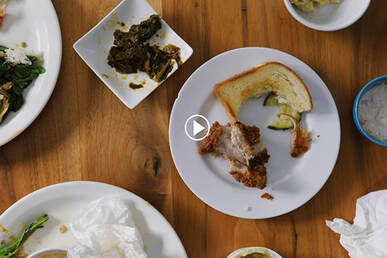 Guest Blog | Food Waste Stops with Me Food waste is a significant challenge for restaurants and hotels. Not only is it bad for the environment, but it also costs businesses money. One aspect of food waste that can be particularly tricky is customer plate waste. Unlike kitchen waste, where chefs have complete control over what goes into the trash, what is left on the plate can be tricky to manage because we don't always get feedback on why certain items are uneaten. However, there are some steps that the hospitality industry can take to minimize customer plate waste without sacrificing service or satisfaction. 1. Monitor Monitoring and tracking food regularly left on the plate is essential so restaurants and hotels can identify trends and make adjustments to reduce waste. Consider tracking food waste by meal or day of the week to identify areas of improvement. 2. Adjust Menu design can play a huge role in reducing plate waste. Offering flexible menu options, such as customizable meals or à la carte options, can allow customers to choose exactly what they want and reduce the likelihood of wasted food. Monitor menu items that are being wasted and adjust their offerings accordingly. For example, if a particular dish, side, condiment or garnish is consistently left on the plate, the portion can be reduced or removed from the menu. This not only reduces waste but also saves money on ingredients. One of the biggest reasons for customer plate waste is oversized portions. Customers may be hesitant to order smaller portions for fear of not getting their money's worth, so offering a range of portion sizes, ala carte options or customizable dishes and pricing accordingly can help to alleviate this concern. Additionally, using smaller plates can create the illusion of a fuller plate without increasing the amount of food served. 3. Communicate Sharing with staff the benefits of reducing plate waste can go a long way. Educating staff on portion control, menu design, and food waste reduction can help them understand the importance of minimizing plate waste and achieving this goal. Additionally, staff can be taught to ask customers about their food preferences, allergies, and portion sizes to help guide their meal choices and prevent waste. By implementing these best practices, restaurants and hotels can minimize plate waste while improving customer satisfaction and saving money. Furthermore, preventing food waste can help to promote a more sustainable and environmentally friendly food industry. Check out this video from the Food Waste Stops with Me initiative for more details and insight. Food Waste Stops with Me is a collaboration between Metro, the Oregon Restaurant & Lodging Association, the Oregon Department of Environmental Quality, as well as city and county governments to help food service businesses reduce food waste. Visit FoodWasteStopsWithMe.org for more food waste prevention resources or to request free assistance from a local food waste reduction specialist. This guest blog was submitted by Food Waste Stops with Me. For more information on guest blog opportunities, contact Marla McColly, Business Development Director, Oregon Restaurant & Lodging Association.
Comments are closed.
|
Categories
All
Archives
June 2024
|
Membership |
Resources |
Affiliate Partners |
Copyright 2024 Oregon Restaurant & Lodging Association. All Rights Reserved.
8565 SW Salish Lane Suite 120 | Wilsonville, OR 97070-9633 | 503.682.4422 | 800.462.0619 | Contact Us
Site Map | Accessibility | Privacy Policy
8565 SW Salish Lane Suite 120 | Wilsonville, OR 97070-9633 | 503.682.4422 | 800.462.0619 | Contact Us
Site Map | Accessibility | Privacy Policy

 RSS Feed
RSS Feed


